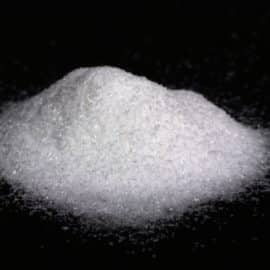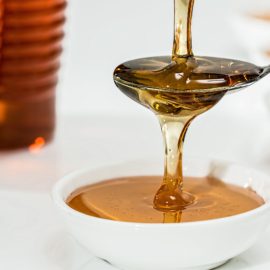
Emulsifiers are used as a key ingredient in ice cream. As a food additive, they hold several functions, depending on the food. Generally, they help increase food palatability, increase food volume and aeration, decrease stickiness, improve food flavor, enhance food textural properties, and impart foam stability.
In ice cream, emulsifiers helps the ice whip more readily. The ice cream also becomes dryer, has better melting resistance, is smoother, and has a better texture. In some ice cream, emulsifiers also destabilize the milk protein in the final ice cream product to improve its structure. Because of their relatively higher surface activity and ability to form liquid crystal metaphases, emulsifiers in ice creams tend to promote protein desorption from the surface of fat droplets. Emulsifiers serve as nucleation sites for triglyceride surface crystallization. They also aid in the formation and stabilization of ice cream foam prior to partial fat globule coalescence and freezing.
You might also like: Emulsifiers In Food: What Are They?
Traditional emulsifiers for ice cream production include egg yolks. They contain lecithin, a natural emulsifier that aids in uniting the molecules of fat and water to produce a creamy and smooth texture. Egg yolks are a common ingredient in custard-based recipes because they give ice cream a richness and depth of flavor.
Today, there are many emulsifiers that can be used for ice cream making. Aside from lecithin from egg yolks, mono-/diglycerides, and polysorbates are commonly used. These emulsifiers are often used as blends.
Let’s discuss them briefly.
HOW EMULSIFIERS WORK IN ICE CREAM
Emulsifiers have a unique chemistry. They have molecules with two ends, one of which is drawn to water and the other to fat. The water-loving end of an emulsifier’s molecule surrounds the water droplets in an ice cream mixture, while the molecule’s fat-loving end surrounds the fat droplets. Small emulsion droplets are produced as a result, which the emulsifiers stabilize and disperse throughout the mixture.
The emulsified fat droplets are broken down into smaller pieces as the ice cream mixture is frozen and churned, giving it a smooth and creamy texture. Without emulsifiers, the ice cream’s fat would collect into lumps, giving it a grainy or lumpy texture. Additionally, emulsifiers aid in preventing the growth of large ice crystals, which can cause the ice cream to separate.
In order for emulsifiers to function properly, the aging must be adequate. During this stage of production, emulsifiers adsorb to the surface of the fat droplets, and partially replace the milk proteins. The emulsifiers start to crystallize as the mix cools. This makes them more hydrophobic. Thus, they adsorb more onto the fat droplets. When the ice cream mix is frozen, it is challenging to incorporate and stabilize air bubbles without them. This is especially true in the industrial setting. The nature of the mix and the intended use determine the aging time, which in turn determines the degree of fat crystallization and emulsifier adsorption.
Aging of mixtures of extruded products for at least 6 hours causes greater partial coalescence. This usually results in a stiffer ice cream. For most types of ice cream products, two hours of aging is sufficient. In factories, it is convenient to age a mixture over night and store it in aging tanks prior to production. Ideally, it should not be kept for more than three days.
EGG YOLK
Egg yolk contains several components that make it a great functional ingredient in food manufacturing.
But in ice cream making, lecithin is the most important as it contributes the most to egg yolk’s emulsifying abilities. The approximate weight percentages of the components of an egg yolk are: 50% water, 16% protein, 9% lecithin, 23% other fat, 0.3% carbohydrate, and 1.7% minerals. Lecithin is made up of phospholipids and phosphatides. It is frequently utilized in premium, homemade, or “all-natural” ice creams
Lecithin does its job by combining the molecules of fat and water to produce a creamy, smooth texture. Without it, ice cream mix can become icy or grainy. Additionally, lecithin aids in stabilizing the ice cream, preventing it from melting too quickly or freezing up too hard. It can aid in lowering overrun (the amount of air whipped and incorporated into the ice cream) of the product.
You might also like: The Science Of Making Ice Cream
Egg yolk is typically supplied for use in the production of ice cream in one of three forms: pasteurized fresh egg yolk, frozen pasteurized sugared egg yolk, or dehydrated egg yolk. Normal usage levels of egg yolk solids range from 0.5% to 3%. Frozen pasteurized sugared egg yolk often contains 10% sucrose to prevent damage during freezing. Super-premium ice cream products may contain high concentration to give ice cream an eggy flavor.
MONO-/DIGLYCERIDES
Mono- and diglycerides are emulsifiers that are made up of a glycerol molecule and one or two fatty acid molecules attached to it. Mono- and diglycerides are lipids or fats that are soluble in both fat and water. This unique property enables them to function as emulsifiers, assisting in the combination and stabilization of fat and water-based ingredients in food products such as ice cream.
Due to the hydrophilic nature of the glycerol end and the hydrophobic nature of the fatty acid end, mono- and diglycerides are surface active. The fatty acids in mono- and diglycerides determine their characteristics, just like they do for triglycerides. Vegetable fats like soybean oil and palm oil that have undergone partial hydrolysis are used to create mono- and diglycerides. They typically contain diglyceride, a small amount of triglyceride, and monoglyceride in amounts ranging from 40% to 60%.
You might also like: How Salt And Ice Bath Freezes Ice Cream Faster
Ice cream production frequently uses fully saturated mono-/diglycerides that primarily contain stearic and palmitic acids. An example of this is glycerol monostearate, which typically makes up about 0.3% of the ice cream mix. This is ideal for low fat ice cream since it provides smooth texture and body similar to regular ice cream.
POLYSORBATES
As opposed to mono- and diglycerides, polysorbate types of emulsifiers are known to be more effective at displacing proteins from the oil-water interface, making them better emulsifiers for ice cream. However, the mono- and diglycerides have better foaming properties, which means they can create more initial foam before the fat droplets clump together at the air-water interface.
Monoglycerides and sorbitan esters of fatty acids share structural similarities. Polyoxyethylene sorbitan monooleate, commonly called polysorbate 80, is present in many products in a reasonable amount, keeping the ice cream scoopable. Instead of glycerol, polysorbate 80 has a fatty acid attached to a sorbitol molecule. The sorbitol molecule also has polyoxyethylene groups attached to it, making it water soluble. When used as an ice cream emulsifier, polysorbate 80 can be used at concentrations of 0.02% to 0.04%. Like most food additives, polysorbates are safe to consume in moderation, and are subject to regulation by food safety authorities.
References:
M. Wallert, K. Colabroy, B. Kelly, J. Provost (2016). The Science of Cooking: Understanding The Biology And Chemistry Behind Food And Cooking. John Wiley & Sons, Inc..
Chris Clarke (2004). The Science of Ice Cream: RSC (2nd edition). RSC Publishing.
P. Cheung, B. Mehta (2015). Handbook of Food Chemistry. Springer
T. Msagati (2013). Chemistry of Food Additives and Preservatives. John Wiley & Sons, Ltd.


